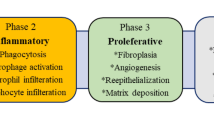Abstract
Aim
The aim of this study is to assess the effects of triester glycerol oxide (TGO) on cutaneous wound epithelization process.
Material and methods
Fifty-four male Wistar rats were divided into 2 groups of 27 rats each: control(C) and TGO (PX). The groups have been divided into three subgroups which included nine rats each regarding the wound excision on the 3rd, 7th, and 10th days, respectively. The specimens were evaluated according to histological properties and hydroxyproline levels.
Results
Seventh day examination showed that PX and control groups present the same score. HP levels in the control group were significantly lower compared to PX groups.
Conclusion
TGO have positive effects on wound epithelization process by increased collagen synthesis.










Similar content being viewed by others
References
Sehn E, Hernandes L, Franco SL, Gonçalves CC, Baesso ML (2009) Dynamics of reepithelialisation and penetration rate of a bee propolis formulation during cutaneous wounds healing. Anal Chim Acta 635(1):115–120
Pekiner FN, Alatli C, Bayrak S, Sinanoğlu A (2006) Triester glycerol oxide in the treatment of recurrent aphthous stomatitis: a cytological investigation. Pain Clinic 18(3):237–245. doi:10.1163/156856906778026194
Mouly SJ, Orler JB, Tillet Y, Coudert AC, Oberli F, Preshaw P, Bergmann JF (2007) Efficacy of a new oral lubricant solution in the management of psychotropic drug-induced xerostomia: a randomized controlled trial. J Clin Psychopharmacol 27(5):437–443, PMID:17873673
Yilmaz N, Nisbet O, Nisbet C, Ceylan G, Hoşgör F, Dede OD (2009) Biochemical evaluation of the therapeutic effectiveness of honey in oral mucosal ulcers. Bosn J Basic Med Sci 9(4):290–295, PMID:20001994
Eldad A, Weinberg A, Breitermanb S, Chaouatb M, Palankerc D, BIen-Bassatb H (1998) Early nonsurgical removal of chemically injured tissue enhances wound healing in partial thickness burns. Burns 24:166–172, PMID:9625245
Dogan N, Ucok C, Korkmaz C, Ucok O, Karasu HA (2003) The effects of articaine hydrochloride on wound healing: an experimental study. J Oral Maxillofac Surg 61(12):1467–1470, PMID:14663813
Jamall IS, Finelli VN, Que Hee SS (1981) A simple method to determine nanogram levels of 4-hydroxyproline in biological tissues. Anal Biochem 112(1):70–75, PMID:7258630
Ozbek N, Guneren E, Yildiz L, Meydan D, Cakir S, Coskun M (2005) The effect of pre-operative conventional and hyperfractionated radiotherapy schedules on wound healing and tensile strength in rats: an experimental study. Int J Oral Maxillofac Surg 34(2):185–192, PMID:15695049
Breitbart AS, Grande DA, Laser J, Barcia M, Porti D, Malhotra S, Kogon A, Grant RT, Mason JM (2001) Treatment of ischemic wounds using cultured dermal fibroblasts transduced retrovirally with PDGF-B and VEGF121 genes. Ann Plast Surg 46(5):555–561, PMID:11352431, discussion 561–2
Shetty V, Bertolami CN. Peterson’s principles of oral and maxillofacial surgery. 2nd ed. Hamilton • London: BC Decker Inc; 2004. Chapter 1, Wound healing; p. 3–17
Açil Y, Gierloff M, Behrens C, Möller B, Gassling V, Niehoff P, Wiltfang J, Simon M (2013) Effects of zoledronate on irradiated bone in vivo: analysis of the collagen types I, V and their cross-links lysylpyridinoline, hydroxylysylpyridinoline and hydroxyproline. Calcif Tissue Int 92(3):251–260, PMID:23179106
Author information
Authors and Affiliations
Corresponding author
Ethics declarations
Conflict of interest
None
Funding source
This project was sponsored by Scientific Research Council of Gulhane Military Medical Academy.
Contributions of the authors
Metin Sencimen, Aydin Gülses, and Mustafa Ayna have designed the study and wrote the manuscript.
Serhat Sezgin, İsmail K. Gider, and Fevzi Erdemci have performed the surgical procedures.
Onder Angora has performed the pathological analysis.
Tuncer Cayci has performed the microbiological analysis.
The current study was conducted in the Department of Oral and Maxillary Surgery and Research Laboratories at Gülhane Military Medical Academy.
Additional information
An erratum to this article is available at http://dx.doi.org/10.1007/s10006-016-0602-1.
Rights and permissions
About this article
Cite this article
Sezgin, S., Sencimen, M., Gülses, A. et al. An experimental study on the comparison of the effects of triester glycerol oxide on wound repair. Oral Maxillofac Surg 20, 273–279 (2016). https://doi.org/10.1007/s10006-016-0566-1
Received:
Accepted:
Published:
Issue Date:
DOI: https://doi.org/10.1007/s10006-016-0566-1




